



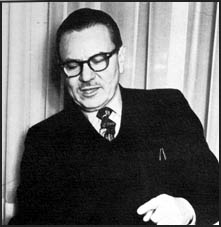
|
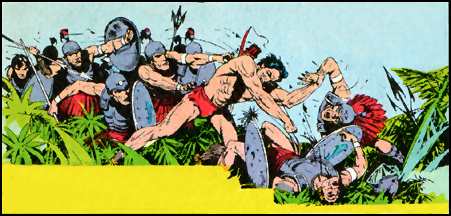 |
Burne Hogarth, like E.A. Abbey last week, started young. Born in 1911, he was enrolled in the Chicago Art Institute at the age of 12 and an assistant cartoonist at Associated Editors' Syndicate at 15. At the age of 26, he was chosen from a pool of a dozen applicants as Hal Foster's successor on the United Features Syndicate strip, "Tarzan". His first strip, very much in Foster's style, appeared May 9, 1937. It wasn't long before he abandoned the attempt to maintain the original look of the strip and brought his own dynamic style to the Sunday comics page. By the time he left the strip in 1945, he had evolved the art past the prevalent commercial illustrative styles of Alex Raymond and Foster, and the moody noir of Caniff and Sickles.
It would take comic books several decades to integrate the lessons of Hogarth into their pages, and don't think they weren't trying. The techniques of movement and layout were to reverberate through a new generation of artists in the developing field through Hogarth's teachings and books.
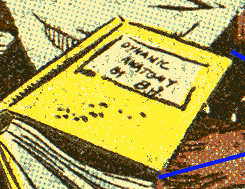
|
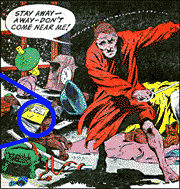 |
| A splash panel from a 1955 George Woodbridge story, with lessons from Hogarth (note the folds and muscles), and a preview of his 1958 book, Dynamic Anatomy. | |

|
|
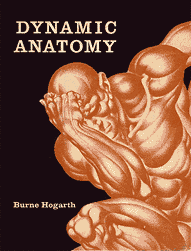 The
School of Visual Arts was a magnet for that next
generation of comic book artists mentioned above. Hogarth's considered
approach to the adventure strip was made to order for comics.
Al Williamson, George Woodbridge, Wally Wood, and a host of others drank from
the well. What was so special about Hogarth's approach is that
he had thought deeply on the elements of action and the tensions
it produced and translated his thoughts into a rigorous approach
to foreshortening and shadows. He was able to pass these methods
on to his students in the classroom and, in 1958, to the readers
of his first book, Dynamic Anatomy.
The
School of Visual Arts was a magnet for that next
generation of comic book artists mentioned above. Hogarth's considered
approach to the adventure strip was made to order for comics.
Al Williamson, George Woodbridge, Wally Wood, and a host of others drank from
the well. What was so special about Hogarth's approach is that
he had thought deeply on the elements of action and the tensions
it produced and translated his thoughts into a rigorous approach
to foreshortening and shadows. He was able to pass these methods
on to his students in the classroom and, in 1958, to the readers
of his first book, Dynamic Anatomy.
This was followed by: Drawing the Human Head (1965), Dynamic Light and Shade, (1981), and Dynamic Wrinkles and Drapery (1992), plus Dynamic Figure Drawing and Drawing Dynamic Hands.
Most of his writing came after he retired from the School of Visual Arts in 1970. He was able, through his books, to influence and instruct yet another generation of artists.
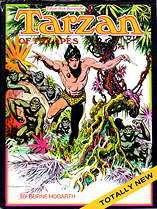
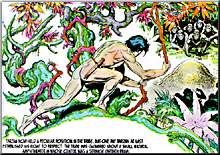 For
the rest of us, one of the most immediate benefits was the release
in 1972 of a totally new "Tarzan" book adapting
the first Burroughs novel, Tarzan of the Apes. It was in
full, almost garish color. Suddenly the gnarled jungles from the
'40s had grown up. Their twisted forms offsetting the idealized
form of Tarzan. Their colors hinted at a threatening difference
- an alien world against which humanity struggled. This was Tarzan
as few of us had seen him; after all Hogarth hadn't drawn the
strip since 1950 and we didn't have Fantagraphics to reprint them
all for us back in 1972.
For
the rest of us, one of the most immediate benefits was the release
in 1972 of a totally new "Tarzan" book adapting
the first Burroughs novel, Tarzan of the Apes. It was in
full, almost garish color. Suddenly the gnarled jungles from the
'40s had grown up. Their twisted forms offsetting the idealized
form of Tarzan. Their colors hinted at a threatening difference
- an alien world against which humanity struggled. This was Tarzan
as few of us had seen him; after all Hogarth hadn't drawn the
strip since 1950 and we didn't have Fantagraphics to reprint them
all for us back in 1972.
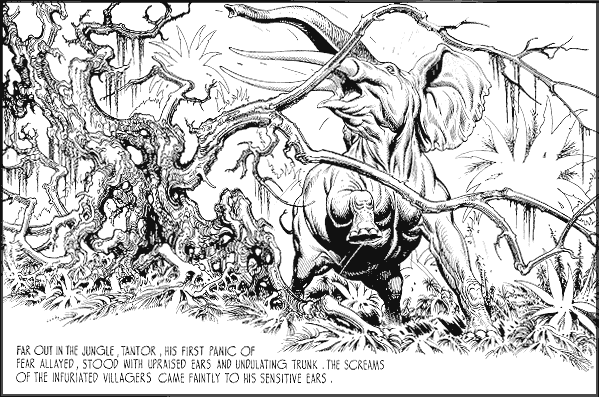
1976 brought another treat, Jungle Tales of Tarzan: four brand new "Tarzan" stories by Hogarth illustrated in black and white. The stories ranged from adventure to philosophy to religion to surreality. Hogarth was at his peak and he pulled out all the stops to make this his most impressive version of Tarzan yet. It was stunning. The jungle bent and curled so intensely that a giant snake is nearly lost in its branches. The lack of color spurred Hogarth on to greater heights of rendering. It was to be his last real Tarzan book and I think it's his best.
Another aspect of this book that is often overlooked is the 30-page essay in the beginning, Burne Hogarth and the Art of Pictorial Fiction, by Walter James Miller. It showed aspects of his work that were tantalizing and he shared some of his thoughts on the medium and the process of comic strips. These were to be further amplified in a pair of interviews by Gary Groth in The Comics Journal #166 and #167. There Hogarth reveals himself as a deep thinker with an amazing memory and a reasoned opinion about everything. Great reading, if only for the historical anecdotes if you're not into philosophy.
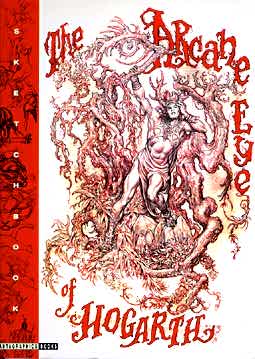
 Over
the years his work would appear sporadically: a plate in the National
Cartoonist Society portfolio, two portfolios of King Arthur. The
1992 publication of The Arcane Eye of Hogarth provided
the final piece of the puzzle by showing us his sketchbook pages;
showing us how he developed an image, and most satisfying, his
preliminary pen work.
Over
the years his work would appear sporadically: a plate in the National
Cartoonist Society portfolio, two portfolios of King Arthur. The
1992 publication of The Arcane Eye of Hogarth provided
the final piece of the puzzle by showing us his sketchbook pages;
showing us how he developed an image, and most satisfying, his
preliminary pen work.
 You can find out more about Burne Hogarth in the following
books:
You can find out more about Burne Hogarth in the following
books:| Dynamic Anatomy | Burne Hogarth, 1958 Watson Guptill |
| Drawing the Human Head | Burne Hogarth, 1965 Watson Guptill |
| The World Encyclopedia of Comics | Maurice Horn, 1976 Chelsea House |
| Jungle Tales of Tarzan | Hogarth, 1976 Watson-Guptill |
| Dynamic Light and Shade | Burne Hogarth, 1981 Watson Guptill |
| Dynamic Wrinkles and Drapery | Burne Hogarth, 1992 Watson Guptill |
| The Comics Journal #166 and 167 | Gary Groth, 1994 Fantagraphics |
| The Vadeboncoeur Collection of Knowledge | Jim Vadeboncoeur, Jr. 1998 |
|
Illustrations copyright by their respective owners. This page written, designed & © 1998 by Jim Vadeboncoeur, Jr. Updated 2011. |
